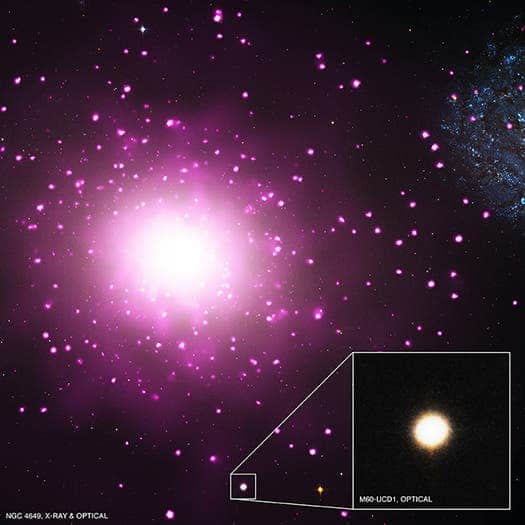
This galaxy weighs more than 200 million suns, over half of which is concentrated within a radius of just 80 light years. (c) NASA/CXC/MSU/J.Strader et al, Optical: NASA/STScI
Using NASA’s Hubble Space Telescope, followed by observations done with NASA’s Chandra X-ray Observatory and ground-based optical telescopes, astronomers have identified what’s considered to be the densest galaxy found so far in the nearby part of the Universe. Classed as an “ultra-compact dwarf galaxy” and dubbed as M60-UCD1, the density of stars in the galaxy is about 15,000 greater than that found in Earth’s neighborhood in the Milky Way, meaning that the stars are about 25 times closer.
Subsequent observations made by the W. M. Keck Observatory on the summit of Mauna Kea, Hawaii, found M60-UCD1 to be the most luminous galaxy of its type observed thus far, while being one of the most massive at the time – about 200 million times the mass of the sun. Now for a galaxy, this kind of mass isn’t large by any means but what makes M60-UCD1 unique is that half of its mass is concentrated around a radius a mere 80 light-years across. Furthermore the galaxy is also particularly interesting because it is abundant in heavy elements making it a potentially fertile environment for planets, and maybe even life, to form. Were our sun to be located in such a galaxy, interstellar flight would be much easier.
“Traveling from one star to another would be a lot easier in M60-UCD1 than it is in our galaxy,” said Jay Strader of Michigan State University in Lansing, first author of a new paper describing these results. “But it would still take hundreds of years using present technology.”
For comparison, our closet neighboring star, Alpha Centauri, is located some 4 light-years away. Even so, using currently available technology, it take roughly 80,000 years for a probe to reach it.
Like most galaxies, M60-UCD1 might also have a black hole lurking at its center. Chandra data that revealed a bright X-ray source coming from the galaxy’s center supports this idea. If true, the giant black hole might weigh 10 million times the mass of the Sun.
Currently, astronomers are trying to establish if galaxies such as M60-UCD1, known as ultra-compact dwarf galaxies, were formed as jam-packed star clusters from the get-go or whether these are actually remnants of larger galaxies who have gotten smaller with time as stars are being ripped away.Large black holes are not found in star clusters, so if the X-ray source is in fact due to a massive black hole, it was likely produced by collisions between the galaxy and one or more nearby galaxies. The mass of the galaxy and the Sun-like abundances of elements also favor the idea that the galaxy is the remnant of a much larger galaxy.
“We think nearly all of the stars have been pulled away from the exterior of what once was a much bigger galaxy,” said co-author Duncan Forbes of Swinburne University in Australia. “This leaves behind just the very dense nucleus of the former galaxy, and an overly massive black hole.”
If this is the case, then M60-UCD1 might have been 50 to 200 times more massive than it is at observation. The researchers estimate that M60-UCD1 is more than about 10 billion years old. The galaxy is located near a massive elliptical galaxy NGC 4649, also called M60, about 60 million light years from Earth.
The densest galaxy fund thus far was described in a paper recently published in The Astrophysical Journal Letters.









